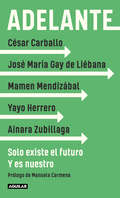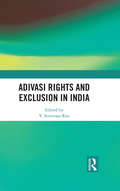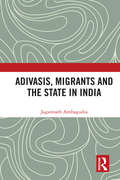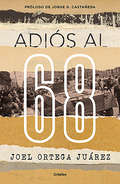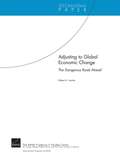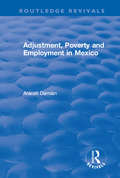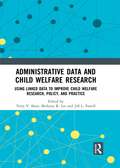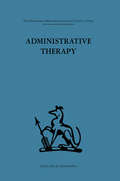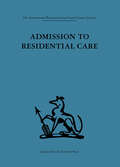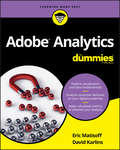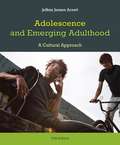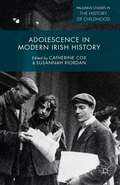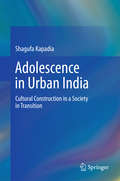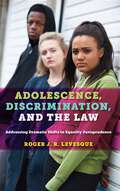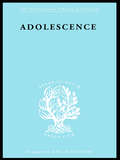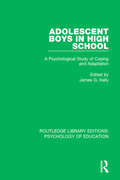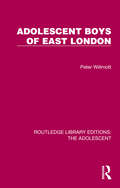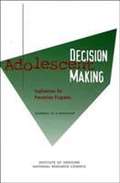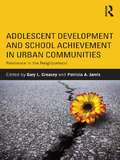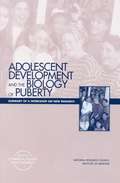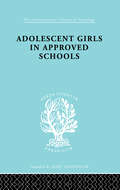- Table View
- List View
Adelante: Solo existe el futuro. Y es nuestro
by José María Gay de Liébana Yayo Herrero¿Seguiremos siendo los mismos después del COVID-19? En el año 2020 se detuvo el mundo. Pandemia, contagios, muerte, cuarentena, distancia social, crispación política, crisis... MIEDO. Pero también solidaridad, heroicidad, resiliencia, creatividad, esperanza, música... FUTURO. ¿Somos más conscientes, como sociedad, de nuestros agujeros? ¿De lo que damos, recibimos, de lo que nos contamos y nos cuentan? ¿Quiénes somos y qué seremos en esta «nueva normalidad»? ¿Cómo será la economía, la educación, la política, la ecología, la sanidad? ¿Hacia dónde se dirigen nuestros pasos? Cinco grandes voces del panorama periodístico, cultural, médico, ecológico, económico analizan, con maestría y rigor, la situación antes y después de la pandemia, dan respuesta a las incógnitas que la «nueva normalidad» nos plantea y aportan soluciones optimistas, porque el futuro, hoy más que nunca, es solo nuestro. Adelante, siempre adelante. Hay libros necesarios para aprender del pasado, para analizar el presente, para entender el futuro. Este libro es uno de ellos.
Adivasi Rights and Exclusion in India
by V. Srinivasa RaoThis volume examines the processes and impacts of exclusion on the Adivasis (tribal or indigenous people) in India and what repercussions these have for their constitutional rights. The chapters explore a wide range of issues connected to the idea of exclusion — land and forest resources, habitats and livelihoods, health and disease management, gender relations, language and schooling, water resources, poverty, governance, markets and technology, and development challenges — through case studies from different parts of the country. The book argues that any laws intended to safeguard the fundamental rights of Adivasis must acknowledge the fact that their diverse and complex identities are not homogenous, and that uniform laws have failed to address their systemic marginalisation since the colonial era. This work appeals for a serious and meaningful political intervention towards tribal development. The volume will be useful to scholars and researchers of tribal and Third World studies, sociology and social anthropology, exclusion studies and development studies.
Adivasis, Migrants and the State in India
by Jagannath AmbagudiaThis book looks at the contested relationship between Adivasis or the indigenous peoples, migrants and the state in India. It delves into the nature and dynamics of competition and resource conflicts between the Adivasis and the migrants. Drawing on the ground experiences of the Dandakaranya Project – when Bengali migrants from erstwhile East Pakistan (now Bangladesh) were rehabilitated in eastern and central India – the author traces the connection between resource scarcity and the emergence of Naxalite politics in the region in tandem with the key role played by the state. He critically examines the way in which conflicts between these groups emerged and interacted, were shaped and realised through acts and agencies of various kinds, as well as their socio-economic, cultural and political implications. The book explores the contexts and reasons that have led to the dispossession, deprivation and marginalisation of Adivasis. Through rich empirical data, this book presents an in-depth analysis of a contemporary crisis. It will be useful to scholars and researchers of political studies, South Asian politics, conflict studies, political sociology, cultural studies, sociology and social anthropology.
Adiós Niño: The Gangs of Guatemala City and the Politics of Death
by Levenson Deborah T.In Adiós Niño: The Gangs of Guatemala City and the Politics of Death, Deborah T. Levenson examines transformations in the Guatemalan gangs called Maras from their emergence in the 1980s to the early 2000s. A historical study, Adiós Niño describes how fragile spaces of friendship and exploration turned into rigid and violent ones in which youth, and especially young men, came to employ death as a natural way of living for the short period that they expected to survive. Levenson relates the stark changes in the Maras to global, national, and urban deterioration; transregional gangs that intersect with the drug trade; and the Guatemalan military's obliteration of radical popular movements and of social imaginaries of solidarity. Part of Guatemala City's reconfigured social, political, and cultural milieu, with their members often trapped in Guatemala's growing prison system, the gangs are used to justify remilitarization in Guatemala's contemporary postwar, post-peace era. Portraying the Maras as microcosms of broader tragedies, and pointing out the difficulties faced by those youth who seek to escape the gangs, Levenson poses important questions about the relationship between trauma, memory, and historical agency.
Adiós al 68
by Joel Ortega Juárez¿Qué queda hoy de una generación a la que se le puede reclamar tanto como se le debe? Adiós al 68 rechaza la mirada contemplativa con la que se ha construido la memoria de los movimientos sociales de la segunda mitad del siglo XX y lo que va del XXI. Con la dolorosa valentía que requiere la autocrítica, confronta al fantasma de aquellos que formaron la conciencia de un mundo mejor, pero que sólo lograron moldear uno distinto. Joel Ortega, quizá el más inteligente miembro activo de la generación mexicana de los años sesenta, hace un recorrido obligadamente incómodo que va de la ilusión a la integración en la política, producto de la Revolución que se deconstruyó para situarse en sus similitudes. Este libro no es sólo el testimonio más honesto que he leído sobre lo que vivió la generación de mis padres, es el retrato de un sobreviviente del 2 de octubre del 68 y del 10 junio del 71, donde convergen Lucio Cabañas, la Liga Comunista 23 de Septiembre, la Unión Soviética, el EZLN, el rechazo al poder hegemónico, la transición de la izquierda a la legalidad y la partidocracia. Este diario político -especie de testamento ideológico- es la crónica de una vida dedicada a pensar, de la metamorfosis de aquella lucha y el anuncio del fin de un ciclo histórico. Maruan Soto Antaki
Adjusting to Global Economic Change: The Dangerous Road Ahead
by David R. Frelinger James T. Bartis Robert A. LevineThe author combines macroeconomic history since the Great Depression with a brief exposition of economic theory that stems from and explains that history, and explores how that experience may apply to the present economic crisis. He warns that we may again be headed for stagflation and makes suggestions for escaping the worst effects of the crisis.
Adjustment, Poverty and Employment in Mexico
by Araceli DamianThis title was first published in 2000: Analyzing the poverty trends in Mexico during the 1980s and early 1990s, this work is concerned with the extent to which changes in the levels of poverty have modified the extent of participation in the labour market. The period covered is 1982 to 1994, when the Mexican economy experienced an economic crisis and the government set in motion the main stabilization policies and structural adjustment reforms. The author challenges the idea that adjustment reforms have had "social costs" in terms of income and formal employment loss. Despite income losses, well-being indicators continued to improve; and employment statistics show that employment grew despite the economic crisis and adjustment. The paradox of household income decline and the increase in income poverty is explained.
Administrative Burden: Policymaking by Other Means
by Pamela Herd Donald P. MoynihanBureaucracy, confusing paperwork, and complex regulations—or what public policy scholars Pamela Herd and Donald Moynihan call administrative burdens—often introduce delay and frustration into our experiences with government agencies. Administrative burdens diminish the effectiveness of public programs and can even block individuals from fundamental rights like voting. In AdministrativeBurden, Herd and Moynihan document that the administrative burdens citizens regularly encounter in their interactions with the state are not simply unintended byproducts of governance, but the result of deliberate policy choices. Because burdens affect people’s perceptions of government and often perpetuate long-standing inequalities, understanding why administrative burdens exist and how they can be reduced is essential for maintaining a healthy public sector. Through in-depth case studies of federal programs and controversial legislation, the authors show that administrative burdens are the nuts-and-bolts of policy design. Regarding controversial issues such as voter enfranchisement or abortion rights, lawmakers often use administrative burdens to limit access to rights or services they oppose. For instance, legislators have implemented administrative burdens such as complicated registration requirements and strict voter-identification laws to suppress turnout of African American voters. Similarly, the right to an abortion is legally protected, but many states require women seeking abortions to comply with burdens such as mandatory waiting periods, ultrasounds, and scripted counseling. As Herd and Moynihan demonstrate, administrative burdens often disproportionately affect the disadvantaged who lack the resources to deal with the financial and psychological costs of navigating these obstacles. However, policymakers have sometimes reduced administrative burdens or shifted them away from citizens and onto the government. One example is Social Security, which early administrators of the program implemented in the 1930s with the goal of minimizing burdens for beneficiaries. As a result, the take-up rate is about 100 percent because the Social Security Administration keeps track of peoples’ earnings for them, automatically calculates benefits and eligibility, and simply requires an easy online enrollment or visiting one of 1,200 field offices. Making more programs and public services operate this efficiently, the authors argue, requires adoption of a nonpartisan, evidence-based metric for determining when and how to institute administrative burdens, with a bias toward reducing them. By ensuring that the public’s interaction with government is no more onerous than it need be, policymakers and administrators can reduce inequality, boost civic engagement, and build an efficient state that works for all citizens.
Administrative Data and Child Welfare Research: Using Linked Data to Improve Child Welfare Research, Policy, and Practice
by Terry V. Shaw, Bethany R. Lee and Jill L. FarrellEvery day, social service agencies collect millions of pieces of data about the children and families they serve. Agencies depend on this data to inform decision-making by personnel throughout the organization and to provide meaningful research and evaluation on program effectiveness and outcomes. As capacity for collecting and utilizing data has increased so has the recognition that this data can and should be used more broadly. Further, it should include not just single-system data, but data across different human service agencies. Administrative/big data systems can be powerful tools in increasing the efficiency and effectiveness of public child welfare services. Understanding, harnessing, and using big data holds tremendous promise in creating transformative change in the social services. Data analytics and data mining can lead to a better understanding of what services work for specific populations (targeting and predictive modelling), provide a more nuanced understanding of service outcomes for the workforce and major stakeholders (transparency), and facilitate collaboration across existing service delivery silos to reduce duplication of services and enhance consumer access to services (efficiency). This book was originally published as a special issue of the Journal of Public Child Welfare.
Administrative Law (Routledge Revivals)
by Peter CaneThis title was first published in 2002. Designed to complement the first volume on administrative law which was published as part of the original series of "The International Library of Essays in Law and Legal Theory", the articles contained in this volume pick up on themes dealt with in the first, while others reflect different concerns and new developments in administrative law scholarship. It offers a representative sample of the best contemporary writing in administrative law - theoretical, empirical and doctrinal. What ties all the essays in this volume together is not that they fall within the province of administrative law, but that they are all concerned with the legal framework within which government business is conducted, and government policies are pursued, by executive action.
Administrative Therapy: The role of the doctor in the therapeutic community
by David H ClarkTavistock Press was established as a co-operative venture between the Tavistock Institute and Routledge & Kegan Paul (RKP) in the 1950s to produce a series of major contributions across the social sciences. This volume is part of a 2001 reissue of a selection of those important works which have since gone out of print, or are difficult to locate. Published by Routledge, 112 volumes in total are being brought together under the name The International Behavioural and Social Sciences Library: Classics from the Tavistock Press. Reproduced here in facsimile, this volume was originally published in 1964 and is available individually. The collection is also available in a number of themed mini-sets of between 5 and 13 volumes, or as a complete collection.
Admission to Residential Care
by Glenys Jones Gwyneth Roberts Paul Brearley Frank Hall Penny GutridgeTavistock Press was established as a co-operative venture between the Tavistock Institute and Routledge & Kegan Paul (RKP) in the 1950s to produce a series of major contributions across the social sciences. This volume is part of a 2001 reissue of a selection of those important works which have since gone out of print, or are difficult to locate. Published by Routledge, 112 volumes in total are being brought together under the name The International Behavioural and Social Sciences Library: Classics from the Tavistock Press. Reproduced here in facsimile, this volume was originally published in 1980 and is available individually. The collection is also available in a number of themed mini-sets of between 5 and 13 volumes, or as a complete collection.
Adobe Analytics For Dummies
by David Karlins Eric MatisoffUse Adobe Analytics as a marketer —not a programmer! If you're a marketer in need of a non-technical, beginner's reference to using Adobe Analytics, this book is the perfect place to start. Adobe Analytics For Dummies arms you with a basic knowledge of the key features so that you can start using it quickly and effectively. Even if you're a digital marketer who doesn't have their hands in data day in and day out, this easy-to-follow reference makes it simple to utilize Adobe Analytics. With the help of this book, you'll better understand how your marketing efforts are performing, converting, being engaged with, and being shared in the digital space. Evaluate your marketing strategies and campaigns Explore implementation fundamentals and report architecture Apply Adobe Analytics to multiple sources Succeed in the workplace and expand your marketing skillset The marketing world is continually growing and evolving, and Adobe Analytics For Dummies will help you stay ahead of the curve.
Adolescence And Emerging Adulthood: A Cultural Approach
by Jeffrey Jensen Arnett Lene Arnett JensenAdolescence and Emerging Adulthood: A Cultural Approach helps you examine this dynamic age period through the lens of the world's diverse cultures. Utilizing a multidisciplinary approach, Jeffrey Jensen Arnett and new co-author Lene Arnett Jensen explore the impact of both cultural and historical context upon development. The text is distinguished by its emphasis on the period of emerging adulthood (ages 18 to 25), a growing area of study. The 7th Edition offers new end-of-chapter reflections that encourage you to consider the big picture. Fresh content in each chapter pertaining to cultural similarities and differences helps you see how the development of adolescents and emerging adults is influenced by the culture in which they live.
Adolescence and Emerging Adulthood: A Cultural Approach
by Jeffrey Jensen ArnettHelps students understand how culture impacts development in adolescence and emerging adulthood. Grounded in a global cultural perspective (within and outside of the US), this text enriches the discussion with historical context and an interdisciplinary approach, including studies from fields such as anthropology and sociology, in addition to the compelling psychological research on adolescent development. This book also takes into account the period of "emerging adulthood" (ages 18-25), a term coined by the author, and an area of study for which Arnett is a leading expert. Arnett continues the fifth edition with new and updated studies, both U. S. and international.
Adolescence in Modern Irish History: Innocence And Experience (Palgrave Studies in the History of Childhood)
by Catherine Cox Susannah RiordanThis edited collection is the first to address the topic of adolescence in Irish history. It brings together established and emerging scholars to examine the experience of Irish young adults from the 'affective revolution' of the early nineteenth century to the emergence of the teenager in the 1960s.
Adolescence in Urban India: Cultural Construction in a Society in Transition
by Shagufa KapadiaSet against the backdrop of social change and globalization, this book presents the contents and contours of adolescence in contemporary urban India. Based on the trends derived from a series of mixed-method studies with adolescent girls and boys, and parents from urban upper middle class families, it explores adolescents' and parents' interpretations of the stage of adolescence, illustrates views on parenting, and discusses approaches to interpersonal disagreements to derive a framework of the parent-adolescent relationship. Drawing from the cultural-contextual perspective of human development, the book in its essence offers a culturally and contextually sensitive model of adolescence that is shaped along the central tenets of family interdependence, harmony, and sensitivity to parental concerns. Highlighted as well are aspects that have remained mostly unexplored, for example, adolescents' capacity for empathy and perspective taking, and emerging issues of autonomy in a primarily relational culture. At a broader level, the book reflects upon the interplay of cultural continuity and change, and contributes to an understanding of globalizing influences on human development. Overall, the depiction of adolescent development captured in the book has significant implications for enhancing family relationships and fostering self-growth---elements that are crucial for positive youth development. The book will be of immense use to scholars in human development, psychology, and allied fields as well as to practitioners who work with adolescents.
Adolescence, Discrimination, and the Law: Addressing Dramatic Shifts in Equality Jurisprudence
by Roger J.R. LevesqueExplores the shifts and the research used to support civil rights claims of discrimination, particularly relating to minority youths’ rights to equal treatment In the wake of the civil rights movement, the legal system dramatically changed its response to discrimination based on race, gender, and other characteristics. It is now showing signs of yet another dramatic shift, as it moves from considering difference to focusing on neutrality. Rather than seeking to counter subjugation through special protections for groups that have been historically (and currently) disadvantaged, the Court now adopts a “colorblind” approach. Equality now means treating everyone the same way. This book explores these shifts and the research used to support civil rights claims, particularly relating to minority youths’ rights to equal treatment. It integrates developmental theory with work on legal equality and discrimination, showing both how the legal system can benefit from new research on development and how the legal system itself can work to address invidious discrimination given its significant influence on adolescents—especially those who are racial minorities—at a key stage in their developmental life. Adolescents, Discrimination, and the Law articulates the need to address discrimination by recognizing and enlisting the law’s inculcative powers in multiple sites subject to legal regulation, ranging from families, schools, health and justice systems to religious and community groups. The legal system may champion ideals of neutrality in the goals it sets itself for treating individuals, but it cannot remain neutral in the values it supports and imparts. This volume shows that despite the shift to a focus on neutrality, the Court can and should effectively foster values supporting equality, especially among youth.
Adolescence: Its Social Psychology (International Library of Sociology)
by C.M. FlemingOriginally published in 1948. This title available in eBook format. Click here for more information.Visit our eBookstore at: www.ebookstore.tandf.co.uk.
Adolescent Boys in High School: A Psychological Study of Coping and Adaptation (Routledge Library Editions: Psychology of Education)
by James G. KellyOriginally published in 1979, the research reported in this volume is based on investigations of how tenth-grade boys cope and adapt to the high-school environment in, specifically, two high schools in suburban Detroit in 1970. In addition to information about the ways that students relate to the high school environment, this volume presents examples of how multiple research methods can be used to investigate the expression of complex person and environment relationships. This volume has been prepared to illustrate the application of an ecological point of view for research on person-environment relationships. It was hoped that the community psychologist, social psychologist, and school psychologist interested in doing research with adolescents and the high school environment would find the presentation of research methods informative and encouraging. For those readers involved in teaching and administering in secondary education, the volume was an example of how research can illustrate the ongoing personal and social characteristics of students and the high school environment.
Adolescent Boys of East London (Routledge Library Editions: The Adolescent)
by Peter WillmottOriginally published in 1966, this is a sociological study of boys growing up in East London. Previous books from the Institute of Community Studies had looked at the lives of other residents of Bethnal Green – couples with young children, middle-aged ‘Mums’, old people, widows. Now the subject is adolescent boys – a study of them not in isolation nor primarily as a ‘problem’ group but as young people moving between childhood and adulthood in the setting of a particular local community. What is it like to grow up in a district like Bethnal Green? How do the boys adjust to the process? What part is played by school, work, youth club, family? What are the boys’ relationships with their fellows and with girls? Where does delinquency fit in? To help answer such questions, a sample of 246 boys aged 14 to 20 were interviewed. The statistical analysis of this survey has been supplemented by illustrative material from diaries, tape-recorded interviews, and informal observation. The outcome is a vivid account, much of it in the boys’ own words, which was rather different from some popular views of contemporary adolescence at the time. Today it can be read and enjoyed in its historical context.
Adolescent Decision Making: Implications for Prevention Programs
by Institute of Medicine National Research CouncilSummary on Adolescent Decision Making.
Adolescent Development and School Achievement in Urban Communities: Resilience in the Neighborhood
by Patricia A. Jarvis Gary L. CreaseyThis timely volume explores essential themes, issues, and challenges related to adolescents’ lives and learning in underserviced urban areas. Distinguished scholars provide theoretically grounded, multidisciplinary perspectives on contexts and forces that influence adolescent development and achievement. The emphasis is on what is positive and effective, what can make a real difference in the lives and life chances for urban youths, rather than deficits and negative dysfunction. Going beyond solely traditional psychological theories, a strong conceptual framework addressing four domains for understanding adolescent development undergirds the volume: developmental continuities from childhood primary changes (biological, cognitive, social) contexts of development adolescent outcomes. A major federal government initiative is the development of programs to support underserviced urban areas. Directly relevant to this initiative, this volume contributes significantly to gaining a realistic understanding of the contexts and institutions within which urban youths live and learn.
Adolescent Development and the Biology of Puberty: Summary of a Workshop on New Research
by Institute of Medicine National Research CouncilAdolescence is one of the most fascinating and complex transitions in the human life span. Its breathtaking pace of growth and change is second only to that of infancy. Over the last two decades, the research base in the field of adolescence has had its own growth spurt. New studies have provided fresh insights while theoretical assumptions have changed and matured. This summary of an important 1998 workshop reviews key findings and addresses the most pressing research challenges.
Adolescent Girls in Approved Schools (International Library of Sociology)
by Helen J. RichardsonThis is Volume I of twenty-eight in the Sociology of Education series. Originally published in 1969, Adolescent Girls in Approved Schools looks at the subject of delinquency in relation to women and girls.
